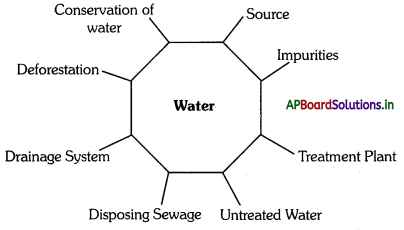Students can go through AP State Board 7th Class Science Notes Chapter 14 Water – Too Little To Waste to understand and remember the concept easily.
AP State Board Syllabus 7th Class Science Notes Chapter 14 Water – Too Little To Waste
→ We are not aware of the need to preserve freshwater.
→ Water resources are not being increased along with the population and their needs.
→ Sewage is a liquid waste.
→ The impurities in water are called contaminants.
→ Nitrates, Phosphates, metals… etc are the inorganic impurities in water.
→ Air is pumped into clarified water to help aerobic bacteria to grow.
→ Aeration causes organisms that break down waste to grow faster thus it leads to what is called a ‘Biological process’.
→ We can conserve water by adopting certain good practices.
→ Only one percent of all water resources is available freshwater.
→ The available resource of fresh water is getting depleted at a very fast pace due to different human activities.
→ Wastewater is generated at homes, industries, etc. by different human activities.
→ All the wastewater released by homes, industries, hospitals, offices, and other users is collectively called Sewage.
→ Sewage is a liquid waste. Most of it is water, which has dissolved and suspended impurities, disease-causing bacteria, and other microbes.
![]()
→ Sewage water contains inorganic, organic, and bacterial as well as other microbial contaminants.
→ Wastewater is treated in treatment plants.
→ Physical, chemical, and biological processes are involved in the treatment of wastewater at the treatment plants.
→ Chlorine kills harmful disease-causing organisms present in wastewater.
→ Aeration allows the growth of microbes that break down wastes.
→ Different types of drainage systems are open, closed, and underground.
→ Septic tanks also help in wastewater disposal.
→ Water should be treated before being released to water bodies.
→ Water must be conserved by individual efforts as well as through efforts made by the community.
→ Sewage: Liquid waste drained from houses, etc. for disposal
→ Wastewater: Water not useful for drinking
→ Contaminants: Pollutants
![]()
→ Septic tank: A type of tank used in houses for human excreta.
→ Drainage s3stem: Arrangement made to carry out wastewater and other material from homes.
→ Percolation tank: The tank which is used for filtration.
→ Contour trenches: An outline, especially of something curved ditch.
→ Bar screen: Rags, sUcks, cans, plastic packets, etc. removes from the waste wat€
→ Grit: Particles of stone or lending, relentless
→ Check dam: A type of dam constructed across a minor channel.
→ Rockfill dam: To conserve water to revive the forest area
→ Activated sludge: Cleaned sludge

→ On World Water Day, that is 22 March 2005, the period 2005-2015 was declared as the International Decade for action on “Water for Life”.
![]()
→ Homi Jehangir Bhabha:
Bhabha was born on October 30, 1909, in a wealthy Paris family. Even as a child he was interested in science. In fact, he studied the special theory of relativity in his 16th year. By that time nobody could understand that theory clearly. Jawaharlal Nehru wanted to make India self-sufficient in science and technology and he gave Bhabha a free hand to do what he wanted.
In 1948 the Atomic Energy Commission was set up and Bhabha made its Chairman. He was a man of refined taste and this way very evident whether it was the. choice of design for the building of the Tata Institute of Fundamental Research or the site for the Ooty radio telescope.
He died in a plane crash at the age of 57. In 1967 the Atomic Energy Establishment, Trombay, was renamed the Bhabha Atomic Research Centre as a tribute to his dedication and work.